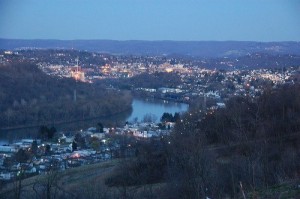NSF: Could deep-Earth microbes help us frack for oil & gas?
From an Article by Sean Cockerham, McClatchy DC News Service, July 28, 2015
On a muddy hill above a World War II ordnance plant that made material for atomic bombs, a fracking crew will drill thousands of feet underground in a search for life itself.
The drilling is a hunt for microscopic organisms, first introduced hundreds of millions of years ago, which have evolved to live in the shale 7,000 feet below the ground, at pressures 600 times that of the surface, and temperatures around 160 degrees F.
Little is known about what lives at those extreme depths and whether the microbes are even down there. But, if found and given a food source that allows them to thrive, they have properties that offer the potential to help drillers pump more natural gas and prolong the U.S. energy boom.
‘Is the Master out of his mind?’ she asked me. I nodded. ‘And he’s taking you with him?’ I nodded again. ‘Where?’ she asked. I pointed towards the centre of the earth. – Jules Verne, “Journey to the Center of the Earth”
Paula Mouser, assistant professor of engineering at Ohio State University, calls it the “next frontier.” Among the life she expects to find in the shale rock more than a mile below the surface of the Earth are organisms that produce methane, the primary component of natural gas. “Imagine a situation where you could actually enhance methane recovery or methane production by providing organisms at these depths what they need to live,” said Mouser.
The researchers have obtained samples containing such bacteria bubbling up from other oil and gas drilling wells. The organisms are rod-shaped critters, some with tails, and have similarities to what is found in the deep ocean.
But those samples were collected after the fracking already happened. So it is not clear whether the microbes were really living far underground, or if they were introduced by outside sources like the water that drillers pump below to fracture the shale rocks and get the oil and gas.
This time will be different. The drillers in the coming months will haul up pristine core samples before the fracking starts. So researchers can see what lives in the shale rock far below. While there’s been study of ocean microbes (some of which eat hydrocarbons and help clean up oil spills), the deep shale rock was long elusive to scientists. There wasn’t so much incentive for companies to spend millions on drilling a well before the fracking boom hit in 2009.
The hunt for life is part of a much broader effort called the Marcellus Shale Energy and Environment Laboratory, or MSEEL. The $11 million MSEEL initiative will give unprecedented access to US Dept. of Energy and university researchers over five years to fracking wells being drilled by Northeast Natural Energy, a company based in Charleston, WV.
Researchers will track air and water quality and measure the environmental effects that have made fracking controversial. Fiber optics in the wells will pinpoint the most efficient ways for drillers to fracture the shale rock with high-pressure water and release the natural gas inside.
Northeast Natural Energy drilling manager Jay Hewitt called the research a valuable chance to explore new technology to pump oil and gas. He has some doubts about the search for deep life, though, saying the shale rock is packed so tight he’s not sure much could be living there. “They’re going to have to prove that to me,” Hewitt said.
The microbes would need to be able to survive incredible conditions, living amid tight and crushing rock, blind darkness and intense heat, packed into higher concentrations of salt than the ocean.
‘Science, my boy, is made up of mistakes, but they are mistakes which it is useful to make, because they lead little by little to the truth.’– Jules Verne, “Journey to the Center of the Earth”
The organisms would need special adaptations to live. That includes osmoprotectants, which would protect them from the high concentration of salt. If isolated in a lab, those have potential use in human medicine for getting pharmaceuticals successfully into the bloodstream, said Mouser of Ohio State, MSEEL’s lead investigator.
Such organisms also produce chemical compounds called biosurfactants, which can make it easier to pump oil and natural gas by causing the shale to become more porous. The chemical compounds help the microbes consume carbon, which they need to build cells and survive.
Mouser, who is working with scientists at West Virginia University and Ohio State University through a National Science Foundation grant, said microbes also can pose problems. They can corrode drilling equipment and clog the rock fractures needed for oil and gas to flow.
The idea is for scientists to figure out how to encourage the beneficial microbes and block the problems. Researchers will collect samples at nine specific depths far below the ground in West Virginia. They’ll extract the biological signs of life from those samples and attempt to culture the organisms in a lab.
Interest is rising in finding methods to more efficiently recover oil and gas as energy prices drop and companies scramble to keep up production with less money. There’s far more natural gas in tight shale rock than drillers can easily tap, according to the Department of Energy, and researchers believe life deep in the shale has the potential to lend a hand.
“We don’t know much about life at these depths in rock,” Mouser said. “And the oil and gas industry doesn’t have a good handle on how small organisms like microbes and bacteria can help oil and gas recovery.”
See also: “Northeast Natural Energy, LLC – Making History for the Future of Energy“

